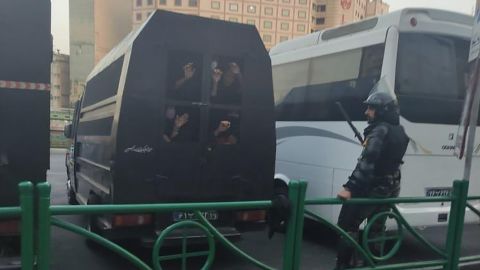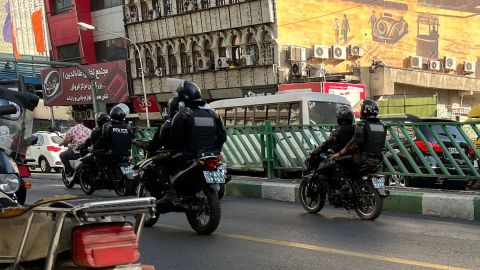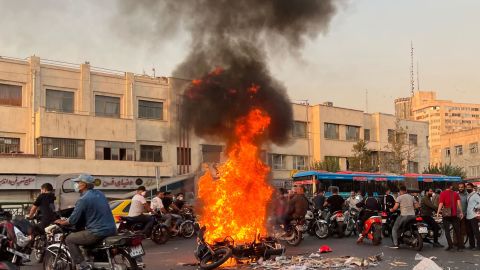CNN
—
Arman doesn’t sleep much anymore.
“In my nightmare, I see someone is following me in the dark, ” he said. “I’m alone and no one is helping me.”
He says his life was forever altered in early October, when he was arrested on the streets of Tehran for joining anti-government demonstrations, and then tortured by Iran’s Revolutionary Guard Corps (IRGC) – known as the Sepah – for four days.
The abuse was psychological and physical, he told CNN, including electric shocks, controlled drowning and mock executions.
The 29-year-old says he was held in solitary confinement and intermittently beaten, before eventually being placed in a room with roughly two dozen other protesters, including a woman with cuts across her face and neck who said she had been sexually assaulted by security forces.
Arman, whose name has been changed for his safety, says he saw the IRGC’s emblem on a desk, and again on the uniform of one of the men guarding him – but that he doesn’t know exactly where in Tehran the center was located because he was tasered and had lost consciousness before being driven there.
In order to leave the detention center, Arman claims he was forced to sign a false confession saying he received money from the US, UK and Israeli governments to go out and create “chaos” in Iranian society. He was then told that if he engaged in any more “activism” he and his family would be hunted down and arrested, he said.
What Arman claims happened to him and those allegedly detained alongside him isn’t an isolated incident. Instead, it’s part of a tried and tested playbook used by the Iranian government to stalk, torture and imprison protesters, in an ongoing campaign to squash political dissent.

In the months following Iran’s nationwide demonstrations in 2019, which were sparked by the government’s abrupt decision to increase the price of gas by 50% but snowballed into calls for the fall of the Islamic Republic and its leaders, widespread accounts of torture and thousands of arrests were documented.
As Iranians from all walks of life unite to fight for their civil rights – in protests first sparked by the death of a young woman in religious police custody last month – it appears to be happening again.
“We are now in the worst time of our life. Full of stress. Full of fear,” a 24-year-old female protester told CNN. She says several of her friends were tortured – and that one of them was also sexually violated – after being detained by the IRGC in Rasht last month.
“Nothing has happened to me yet and I was able to escape. But it is possible at any moment,” she explained during a video call about the incident, her face covered to protect her identity.
CNN has spoken to almost a dozen Iranians who have shared first-hand accounts of torture in either the 2019 and 2022 protests, or who have had loved ones die or disappear while in the custody of authorities.
Some of those impacted shared photographs documenting their injuries as well as court records detailing the criminal charges they’re facing; others shared only their stories, which CNN cannot independently verify.
CNN contacted the Iranian government as well as its permanent mission to the United Nations regarding the accounts of torture and arbitrary detention detailed by protesters but has yet to receive a response.

Farhad, a 37-year-old father-of-two, intimately understands the personal cost of speaking out against the Iranian government, but it hasn’t stopped him from joining the demonstrations which have continued for more than a month now and seem to transcend Iran’s social and ethnic divisions.
In the November 2019 protests, he says he watched several of his friends die on the streets of Tehran after being gunned down by security forces, in what would be a four-day nationwide rampage to silence dissent that ultimately left more than 300 civilians dead, according to Amnesty International.
It wasn’t until December 2, in the aftermath of the bloodshed, that Farhad says plain-clothes officers kicked down his door in the middle of the night to arrest him for his involvement in the demonstrations.
Farhad, whose name has also been changed for his security, says the IRGC used footage of the protests from the BBC – which he has since shared with CNN – to identify him, effectively weaponizing the media coverage of the rallies to hunt down participants.

He claims he was tortured for 16 days in total and like Arman, that he knew the Tehran detention center in which he was being held was run by the IRGC because of a sign on one of its walls displaying its distinctive insignia.
In Farhad’s telling, several hundred people were detained and tortured alongside him. He still hears their screams.
“Hundreds of people were imprisoned with me. There was a bed, people were being tied to it and abused. There were rapes, torture with electric shocks and boiling water … they were hanging people from the ceiling to beat them,” he told CNN.
Farhad’s last memory from his time in that dark room is when he was hung up and beaten senseless by plain-clothes officers before being thrown in the back of a car, driven to an undisclosed location and dumped on the side of the road.
Days later he woke up in a medical clinic near his house in Tehran, he said. He doesn’t know how he got there but cites an extended family member with links to Iran’s government as a possible reason his life was spared.
“My teeth were broken; my lip was completely torn off. Because my bleeding was so severe, I [think] they did not expect me to survive.”
CNN has reviewed photographs of Farhad’s injuries and the scarring he lives with today.
Farjad has since left Tehran with his immediate family for their safety, but says he still receives late-night phone calls from Iranian authorities threatening to rape his wife and kill his children, and that his bank account is periodically frozen.
He also claims that in the months following his torture, his national identity card – the primary document used to access essential services in Iran – was wiped from the system.
Despite the ongoing risks to his life and livelihood, Farhad’s commitment to the current demonstrations is unwavering.
“My country and my people are suffering. The government of the Islamic Republic oppresses in the name of religion, I can’t see people [being] killed for their beliefs anymore,” he said.
CNN spoke with four more protesters who were tortured while in detention and later imprisoned for taking part in anti-government demonstrations in 2019 – including a young single mother who says she has had to place her son in the care of her parents in order to serve prison time, and a 43-year-old father of two from Shiraz who says he suffers from acute post-traumatic stress disorder, after spending 48 days in solitary confinement.
Their accounts all share striking similarities, most notably the ongoing harassment they say their families face from Iranian authorities via fake social media accounts, late-night phone calls, and local informants whom they believe monitor them for the IRGC intelligence service.
Amin Sabeti is an Iranian cyber security expert who has spent years studying hacking groups with ties to the Islamic Republic, including the IRGC-affiliated ‘Charming Kitten’ group, which was recently sanctioned by the US government for “malicious cyber-enabled activities, including ransomware and cyber-espionage.”
According to Sabeti, who is based in the UK, state-sponsored hackers have a tried and tested method in place to “dox protesters” once they’ve infiltrated their online groups using fake accounts, which involves “sharing photos of them on Twitter, Instagram or Telegram and asking others to share information about them,” while pretending to be concerned for their safety.
“They used the same tactics in the November 2019 uprising,” Sabeti explained, which has led to more tech-savvy demonstrators identifying suspicious accounts and distributing warnings among their networks.
At Tehran’s Ebrat Museum – a repurposed former prison – dramatic displays on the atrocities carried out against Muslim clerics by Shah Mohammad Reza Pahlavi’s police during the revolution have long been used as a propaganda tool to celebrate the “freedoms” won in the Islamic Republic.
And yet, Iran’s Supreme Leader Ayatollah Ali Khamenei – who was himself imprisoned in the 1970s during Pahlavi’s reign – and his security apparatus, have a decades-long legacy of also using mass arrests and torture to control and silence political dissidents – the hypocrisy of which is not lost on protesters today.
The current movement – led and inspired by women – has united Iranians across generations, in what is shaping up to be the biggest threat the regime has faced to date. Notably, it has also survived weeks of rolling internet outages and violent crackdowns.
But as chants of “woman, life, freedom” continue – a rallying cry that’s come to encompass the daily violence and control Iranian women are rising up against – more than 1,000 people have been arrested, according to state news IRNA.

Looking ahead, analysts and exiled activists CNN spoke to are fearful that the authorities will ultimately employ whatever violent tactics they deem necessary to once again, regain some semblance of control.
Already, almost two dozen children – some as young as 11 – were killed by Iran’s security forces during demonstrations in September, according to Amnesty International, in a chilling reminder that no life will be spared. Meanwhile, Iran’s Education Minister Yousef Nouri confirmed last week that student protesters are now being detained in what he termed “psychological institutions,” run by the state.
None of the Iranians CNN spoke with were naive to the fact that their lives – and the lives of their families – are on the line as the uprising rages on, with most going to extreme lengths to protect their personal information online and avoid unnecessary risks while taking to the streets.
Arman still receives threatening phone calls and messages for his activism, but he says he won’t be deterred.
“They torture us, and they are lying to the world, to the international community … Iranians want freedom,” he said. “We don’t want dictatorship. We want to connect with the world.”


